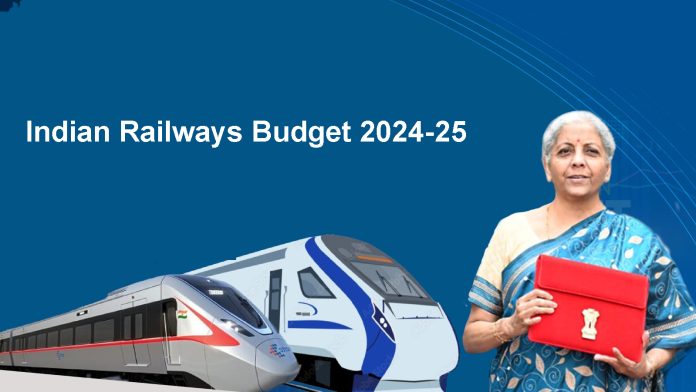By Dr. Gyan Pathak
Indian Railways Budget 2024-25 has clearly shifted its priority from addressing the needs of the poor and common people as a means of mass transport system at affordable travel cost to fulfilling the demands of the aspirational class of the country who can afford the high-cost of railway travel as it is reflected in the focus on Vande Bharat flagship trains apart from developing Amrit Bharat trains and Vande Metro.
This reality of the shift is underplayed by the Minister of Indian Railways Ashwini Vaishnaw by making a statement that the priority of the railways will be safety first, perhaps for pacifying the people’s anger on railway accidents in the recent times that have totally exposed the weaknesses in the Railways safety. “Current Budget estimates are a record allocation for capital expenditure for railways. And majority of this fund will be spent on ensuring safety works,” he claimed.
However, the implementation of the safety measures will remain challenging. Let us take example of the Kavach 4.0, the Automatic Train Protection System, which have already been approved. Vaishnaw himself says, “Kavach consists of multiple components like hardware, software, optical fibre. And India has a diverse network of railway systems, so the challenge is to combine all networks for deployment of Kavach.”
Indian Railways has lost the priority it traditionally been accorded as mass transport system in the public sector before 2016, when PM Narendra Modi led government decided in 2016 to discontinue the practice of a separate budget and to merge with the general Union Budget. Union Minister of Finance Arun Jaitley had presented the first combined budget for FY 2017-18. Thereafter, independent functioning of the Indian Railways has been compromised. It has been systematically restructured and developed at the cost of the government seemingly with the soul purpose of ultimately handing it over to private sector. It is even without a full time Union Cabinet Minister for quite some time. No wonder, the Union Finance Minister Nirmala Sitharaman mentioned the word “Railways” only once in her 83-minute-long budget speech. He speech was largely silent on big-ticket announcement for Indian Railways.
Even though as Railway Minister, Vaishnaw has lauded the Budget 2024-25, which according to him has made a record allocation of over Rs2.55 lakh crore. Of course, it is a jump of 5.85 percent from the previous year’s Rs2.41 lakh crore, but in absolute term it is only an increase of about only Rs14000 crore. When adjusted to cost escalation in one year, it is pittance in reality, which is not enough to address both the requirement of the “aspirational class” and the common people.
The total outlay for capital expenditure is Rs2.65 lakh crore as against Rs 2.62 lakh crore in 2023-24. It was not a big increase, which also includes Rs2.52 lakh crore from general revenues, Rs200 crore from Nirbhaya Fund, Rs3,000crore from internal resources and Rs10,000 crore from extra budgetary resources. This amount will be spent on assets, acquisitions, construction and replacement. However, the Minister of Railways have said that majority of this fund will be spent on ensuring safety works.
The railway budget shows that Indian Railways is still not in good condition. It is going worse in FY 2024-25 as the budget has estimated operating ratio of 98.22 per cent. It was only 98.10 per cent in FY 2023-24. That is Indian railways will have to spend Rs 98.22 to earn Rs 100 in FY 2024-25, while it was spending Rs98.10 in 2023-24.
Out of allocation of 2.55 lakh crore, railways working expenses are to rise from 1.08 lakh crore in the revised estimate of 2023-24 to 1.17 lakh crore in 2024-25, while other ordinary working expenses are to rise from 1.45 lakh crore to 1.55 lakh crore. It means the increase in total outlay from 2.43 lakh crore (RE 2023-24) would be consumed in working and other ordinary working expenses. In this sense there in no real increase in allocation for other important expenses. It means the big things that have been claimed by the Minister of Railways can’t be fulfilled, especially in respect of railways passenger safety, amenities, and comfort. Moreover, the funds will be disproportionately provided for the ‘aspirational class passengers’ rather than for common passengers.
Total Railway Revenue Receipts are projected in the negative (-2.73 lakh crore). The negative trend is projected for all six heads – passenger, other coaching, goods, sundry, suspense, and other miscellaneous receipts. Total budgetary support from the General Revenues is projected at Rs3393 crore against the Rs3271 crore in the revised estimate for the last year. It is only an increase of Rs122 crore, which shows how much the Central government is concerned about the Indian Railways. The Central support is given as reimbursement of losses on operation of strategic lines and debt servicing (interest component) against market borrowings for National projects.
Allocation for new lines is Rs 34602 crore, Gauge Conversion Rs4719 crore, Doubling Rs 29,312 crore, Computerisation Rs 375 crore, and Traffic Facilities – Yard Remodelling and others Rs 8982 crore, and Rolling stock Rs24270 crore. There are not very big increases in allocations compared to last year in these or other schemes.
Budget for the Indian Railways lack proper direction given it to be a mass public transport system that needed greater push for rapid economic development, employment generation, and catering to the transportation needs of the common people.
Congress president Mallikarjun Kharge has said the railway budget very weak adding that the Railways has become “neither here nor there”. He has also said, “Railway accidents are happening every day, trains have been stopped, the number of coaches has been reduced, ordinary passengers are troubled, but nothing has been said about the railways in the budget, there is no accountability.” (IPA S


